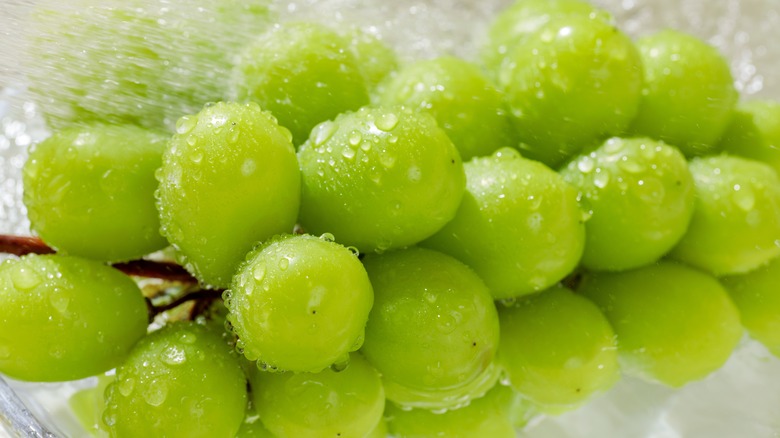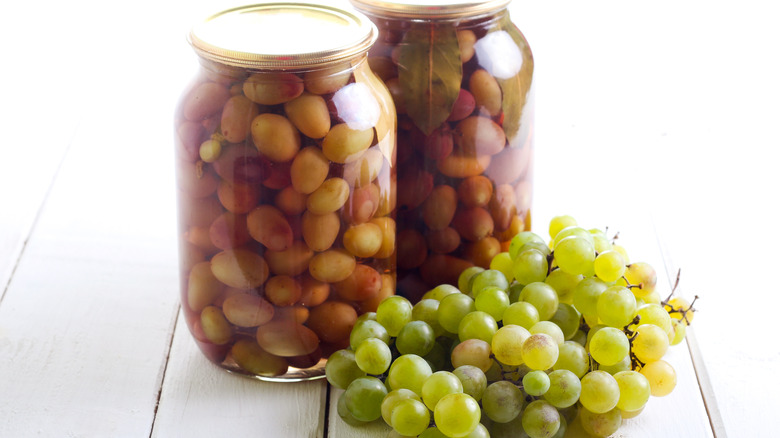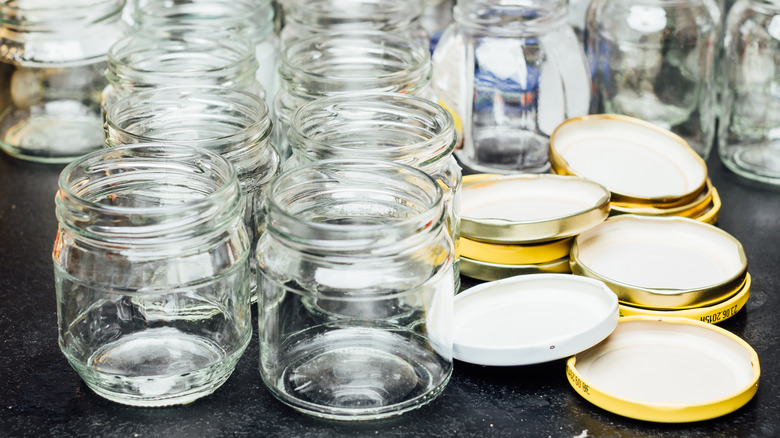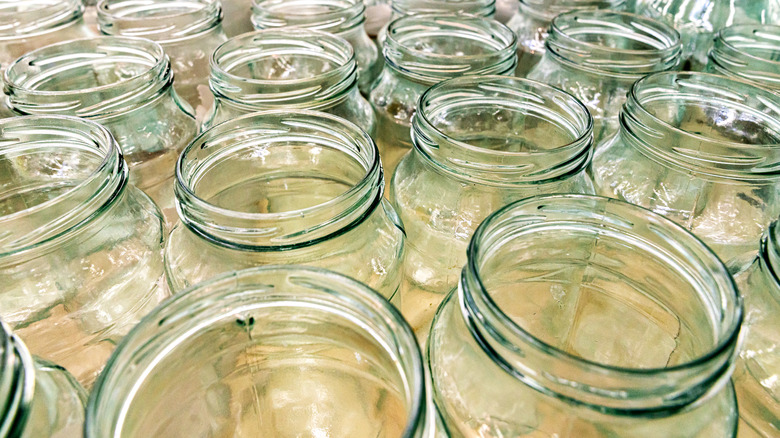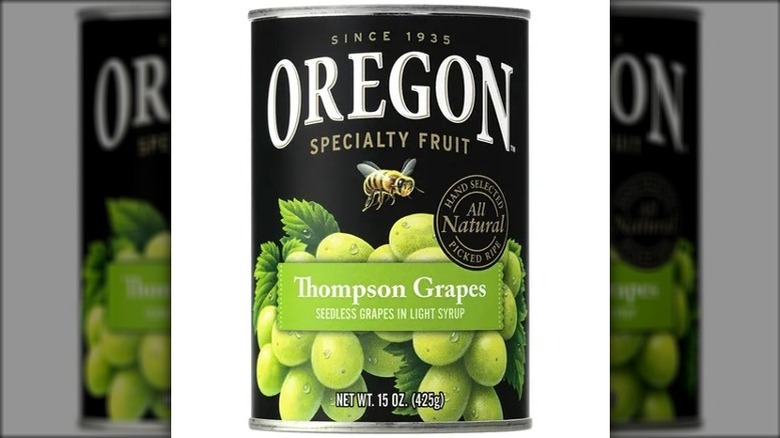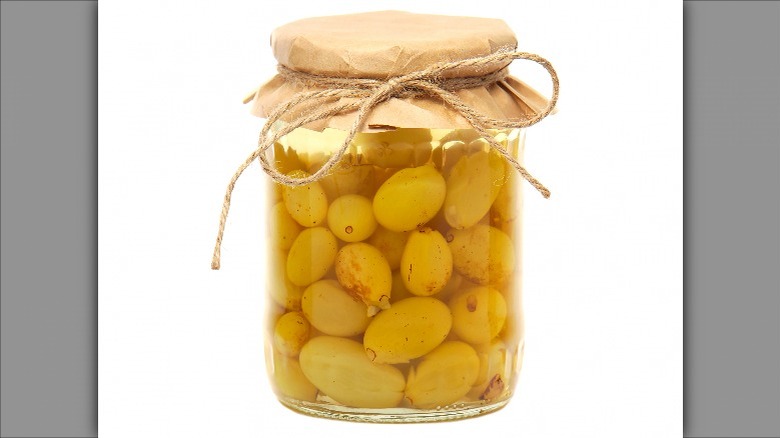The Ultimate Guide To Canned Grapes
If you read the title of this article and wondered, "What are canned grapes?" you're not alone. Quite a few cooking enthusiasts don't know that canned grapes are a thing. Obviously, canned grapes are grapes that come in a can, but there's a lot more to them than that.
Canned grapes can be bought at some supermarkets or farmer's markets, but they are relatively rare. More commonly, they are made at home using basic fruit preserving methods. Doing so is a great way to use up a particularly large harvest of grapes, and canned grapes are a delicious topping for various kinds of desserts, sweets, and other treats.
If you've ever eaten fruit cocktail, you've most likely already tasted canned grapes. In fact, some say the grapes are the best part of these sweet canned fruit salads, and to them we say: You can have it all — as in, an all-grape fruit cocktail! Read on to find out more about this little-known delicacy and about why it deserves a lot more recognition than it gets.
What are canned grapes?
Canned grapes are grapes that come in a can. End of section.
Just kidding! Canned grapes are grapes that have been preserved in a can or, more commonly, a glass jar to extend their shelf life or to create a sweeter treat. There is a distinction to be made here, however. We are not talking about grape jelly, grape jam, or even grape preserves. Canned grapes are exactly what the name implies: full or halved grapes in a can or jar. These grapes were washed thoroughly and put through the canning process make them last much longer than they would otherwise.
Fresh, unwashed, un-canned grapes typically last up to three weeks, but only if they are kept cold. Your refrigerator must be exactly the right temperature, the grapes must get adequate ventilation, and they must be in the crisper drawer. And even then, they might shrivel up before you get to eating them. Canned grapes, on the other hand, can last much longer because of the process used to preserve them.
Canned grapes can also be found in some stores. These canned grapes are truly inside a can — an aluminum one, to be precise — and are usually at least lightly sweetened. Home-canned grapes don't necessarily come in a syrup, but store-brand canned grapes almost always do.
How are canned grapes made?
To make canned grapes, one does not simply toss some grapes into a can. There's a lot more to the process, but here's an overview:
In general, you need 2 pounds of grapes for every quart of home-canned grapes. Water and sugar can be used to make a syrup that will add a sweeter taste. If a syrup is used, it should be very light, as grapes are very sweet on their own. Some grape canners also use ascorbic acid or a mix of lemon juice and water to make an anti-darkening agent that will keep the grapes from changing color over time. The grapes are dipped in this solution after they have been de-stemmed, washed, and dried.
For what is called the "hot pack method" of fruit canning, grapes are blanched in boiling water for 30 seconds and then put into jars. The "raw pack method" leaves out this step. Hot water or syrup is then added to the jars. The lids are placed on the jars, which are then placed in boiling water themselves before being cooled and stored.
What do canned grapes taste like?
The taste of canned grapes can depend on many factors. The canned grapes that you buy at the store taste very sweet because of the syrup they come in. Those that are found in a can of fruit cocktail taste sweet as well but often take on the combined flavors of the other fruit that's in the can with them.
Home-canned grapes typically have a flavor reminiscent of wine, which makes sense, as wine is made from processed grapes. But the flavor also depends on what type of grapes were used and whether or not the grapes are in a syrup. There may also be a slight acidity due to the anti-darkening agent that may have been added to avoid discoloration of the grapes.
Both fresh grapes and canned grapes are sweet, but the latter tends to taste a lot sweeter. In fact, they are so sweet that they are sometimes used to make pies — something that would be hard to imagine doing with fresh grapes. Canned grapes are also softer than fresh grapes since they have been submerged in liquid for an extended period of time, and in many cases, they were blanched before that.
What types of grapes are best for canning?
There are lots of different colors, sizes, and varieties of grapes in the world, and any of them could work for a jar of canned grapes. However, while the type of grape doesn't matter, there is one thing that does: the seeds.
Thompson grapes are the most popular type of grape used for raisins because they do not contain seeds, and they get used for canning as well. This doesn't mean that you can't still can seeded grapes, though. In this case, you would simply have to cut each grape in half and remove the seeds before proceeding with the canning process.
Other important things to remember when choosing grapes for canning are the ripeness of the grapes, their color, and their consistency. The best grapes for this purpose are completely mature, but not overripe, and have a nice, bright, bold, consistent color. They should also be firm to the touch, not shriveled or mushy. While not totally necessary, it is usually recommended to choose grapes that are naturally sweet, as these work very well for canning.
How to use canned grapes
If you've never heard of canned grapes before, you might be wondering what exactly one is supposed to do with them. While some people prefer to just eat them on their own, straight out of the jar with their fingers (or maybe in a bowl with a spoon or fork, like a civilized person), canned grapes also make fantastic additions to many other dishes.
They are perhaps most popular as a part of a homemade fruit salad or fruit cocktail, but you can also add them to a leafy green vegetable salad for a pop of sweetness as well. Canned grapes make a great, mostly diet-friendly topping for yogurt, and those with an even bigger sweet tooth may even try them on top of some vanilla ice cream or lemon sherbet.
Some home chefs highly recommend adding them to porridge or a hot breakfast cereal like Cream of Wheat to add some flavor and a bit of sugar. While it's not one of the better-known pie varieties, there are some recipes for grape pie that use canned grapes as well.
Where to buy canned grapes and canning supplies
First, a small warning: It is hard to find canned grapes in stores. While it is possible to find a can of them on the shelves of a supermarket or a more specialized produce store or farmer's market, you are much more likely to find canned grapes as a secondary character in a can of fruit cocktail. That being said, you can buy them online via sites like Instacart.
Since home canning is a more popular option for canned grapes, you may also want to take a look around for canning supplies. Mason jars are a must, and these can be found online or in many stores like Walmart or Sam's Club, or even in hardware stores like Ace Hardware. To buy the grapes (if you aren't using your own), you can head to your nearest produce department or fruit vendor. And sugar for the syrup can be found at just about any grocery store, making canned grapes an accessible food project for anyone.
Nutrition facts for canned grapes
While the nutritional value of home-canned grapes may vary, we can get an idea of the nutrition facts for canned grapes from the store-bought kind, such as Oregon Fruit Products' canned Thompson grapes. These seedless grapes come in a light syrup and contain around 100 calories per ½ cup of grapes. They have no fat of any kind, saturated or unsaturated, and they contain no cholesterol, either. There are 23 grams of total carbohydrates in ½ cup, with 1 gram being dietary fiber and the rest coming from sugar. These canned grapes are low in protein, with just 1 gram, but they are low in sodium as well with only 10 milligrams, which effectively makes no difference in terms of recommended daily intake.
Since canned grapes will most likely be used as a topping or addition to another dish, it's also important to take the nutritional values of that dish into account to get the full picture of whether the grapes are a healthy addition to your diet or not.
How to store canned grapes
Canning may seem like a storage method for grapes in and of itself, but even canned grapes have some dos and don'ts when it comes to storing them. First of all, when it comes to home-canned grapes, you should add a label to each jar with the date it was canned so that you will be able to tell how long the grapes have been in storage. Most canned grapes made at home should last around a year in storage if they are properly sealed and kept in a cool, dry place with no light.
Store-bought canned grapes, on the other hand, can last for around 18 months in similar storage conditions, but only if the can has remained unopened. With metal cans, it is especially important to keep them in a dry place, because moist environments can lead to rust and corrosion. Once opened, you can store canned fruit in the refrigerator for five days to a week. If the fruit is from the store, it is recommended to take it out of the metal can and put it in a plastic or glass container to preserve the flavor.
